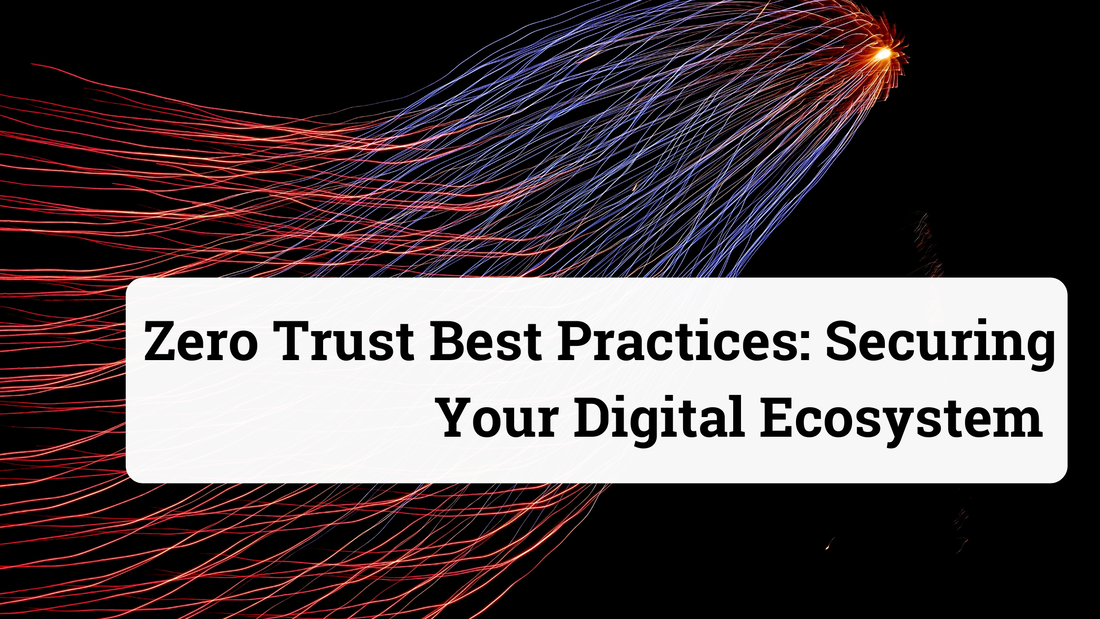|
In today's dynamic and interconnected digital landscape, traditional security models that rely on perimeter defenses are no longer sufficient to protect against the sophisticated and evolving cyber threats. As the cyber landscape becomes increasingly complex, organizations are adopting a more proactive and comprehensive security approach: the Zero Trust model. Zero Trust best practices have emerged as a game-changing strategy to safeguard valuable assets and data from cyber threats. In this article, we will highlight essential best practices to implement this groundbreaking security framework effectively. Essential Zero Trust Best Practices: As highlighted in our previous article, Zero Trust is based on the principle of “never trust, always verify again and again”. Here are some best practices to help you implement this model effectively. 1. Identify and Classify Assets The first step in implementing Zero Trust is identifying and classifying all digital assets, including data, applications, and devices. Understanding the value and sensitivity of each asset helps you to prioritize your organization’s protection and allocate resources effectively. 2. Regular Security Audits and Penetration Testing Regular periodic security audits and penetration testing help identify vulnerabilities and weaknesses in the security infrastructure cyberattackers could utilize to enter and compromise your network. This is extremely important as one of the first steps to Zero Trust security is understanding the current state of your network security. Do you have cybersecurity defenses? If yes, how effective are they? Regular testing enables organizations to address potential issues promptly and improve their security posture. 3. Verify All Devices Verifying your users is one of the first steps of the principles of Zero Trust. This extends to endpoint devices, which includes but is not limited to mobile devices, desktop computers, embedded devices, servers and virtual machines. Verification includes ensuring that any device that is used to access your internal resources does meet the security requirements of your company. It is essential to look for a solution that allows you to easily track and enforce all device status with easy user onboarding and offboarding. Adopt a risk-based assessment that initiates the verification process when the system detects a possible intrusion to make it a good user experience. 4. Implement Strong Authentication Adopting multi-factor authentication (MFA) is fundamental to Zero Trust best practice. Requiring users to provide multiple verification factors, such as biometrics (i.e. fingerprint scan, retina scan, voice scan or face scan), tokens, or one-time passwords, adds an extra layer of security beyond traditional username and password combinations. 5. Least Privilege Access Applying the principle of least privilege ensures that users and applications only have access to the specific resources they need to perform their tasks. This principle is based on the ideology that a particular user should be granted just enough privileges to allow them to complete a particular task. This minimizes the potential impact of a security breach and reduces the attack surface. Least privilege access can also include “just in time” privileged access, whereby this will restrict privileges to only specific time when they are needed. This includes one-time-use credentials and privileges that expire. 6. Continuous Monitoring and Analytics Real-time monitoring and behavioral analytics are essential components of Zero Trust. Continuously monitoring user activities, network traffic, and application interactions enables the timely detection of suspicious behavior or anomalies. This is especially important for users who have administrative rights due to the large scope of access permissions and the highly sensitive nature of the data they can access. 7. Secure Access for Remote Users With the rise of remote work and mobile devices, secure access for remote users is critical. Zero Trust best practices include implementing secure remote access technologies such as virtual private networks (VPNs) and secure remote desktops. 8. Encrypt Data & Communications Encrypting sensitive data both at rest and in transit is a core Zero Trust practice. As your data could get into the hands of unauthorized users, it is an act of negligence if the data is unencrypted. Data and communication encryption means encoding it so that only verified users can read it. Hence, this ensures that even if data is intercepted, it remains unreadable and inaccessible to unauthorized individuals. 9. Incorporate Network Segmentation Network segmentation is a critical Zero Trust practice that involves dividing the network into smaller, isolated segments. This will help you restrict access to your components. Rather than unlimited access, users inside the network have limits to what they can access. This ensures that even if one segment is compromised, the attacker’s access is limited. Hence, the damage they can do will be limited as well. Takeaway As cyber threats continue to evolve, the Zero Trust model has emerged as a leading cybersecurity strategy to protect against advanced attacks. By adopting these best practices, organizations can build a robust security framework that continuously verifies users, devices, and applications, ensuring the protection of valuable assets and data. Implementing Zero Trust is a proactive step towards safeguarding the digital ecosystem, enabling organizations to navigate the ever-changing cyber landscape securely and confidently. Cyber Security For Organizations with TAFA With the current cyber environment, organizations are facing increasingly sophisticated cyber threats. To protect against these threats, it is necessary to utilize cybersecurity solutions that can prevent zero-day and advanced cyber threats and help ensure regulatory compliance. With our prevention first and zero-trust approach to security using machine learning (ML) and artificial intelligence (AI), TAFA Shield will strengthen your company's ability to prevent and block cyber attacks and threats. To learn more information about TAFA Shield and how we can help your company, do not hesitate to contact us for more information. Related Topics What is the Zero Trust Model? Definition, Principles and It’s Benefits Why do businesses need to be cyber secure? Is it as important as emphasized everywhere? 7 Types of Cybersecurity Measures SMEs Need to Protect Their Business Comments are closed.
|
Archives
June 2024
Categories
All
|
|
© 2021, TAFA HOLDINGS (S) PTE LTD. ALL RIGHTS RESERVED
|


 RSS Feed
RSS Feed